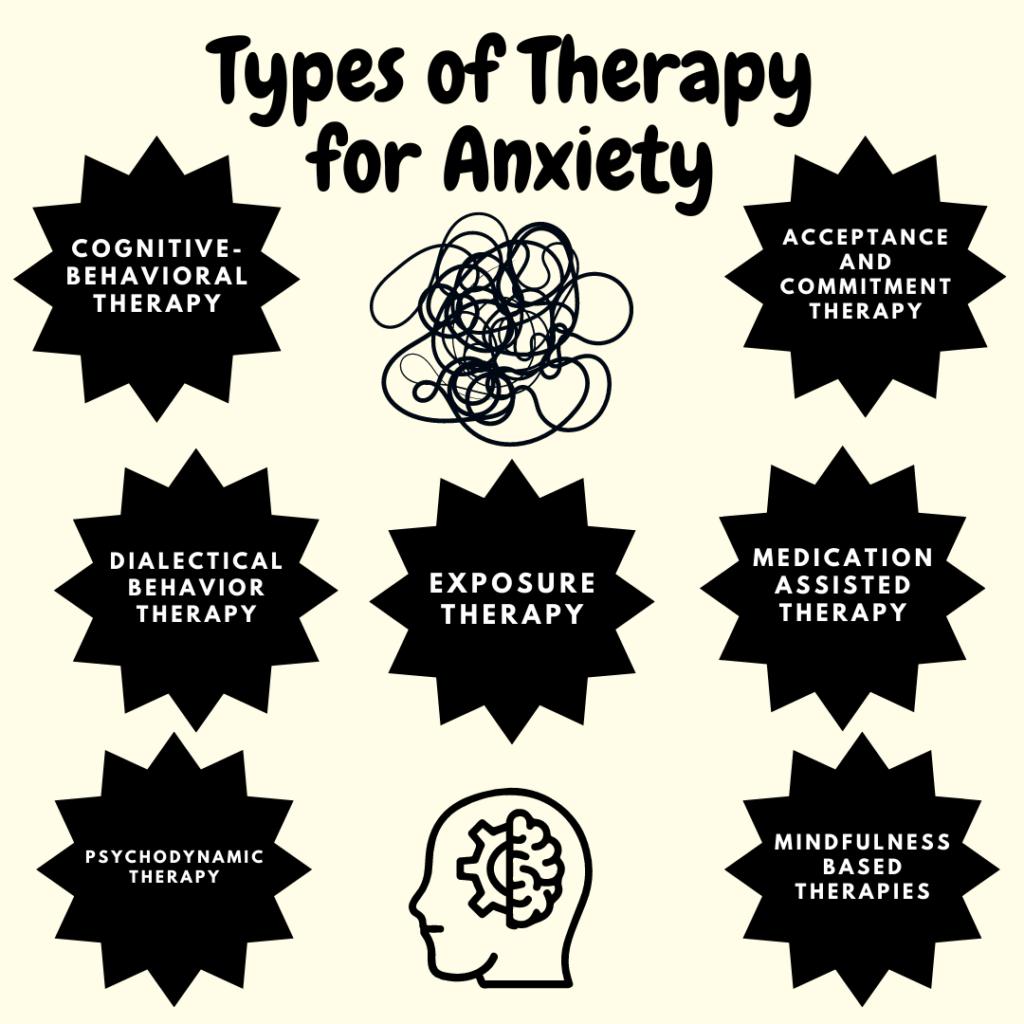Anxiety disorders are among the most common mental health conditions, affecting millions worldwide. While medication can provide temporary relief, therapy remains the most effective long-term solution for managing anxiety. This article explores various therapeutic approaches, including Cognitive-Behavioral Therapy (CBT), Exposure Therapy, Mindfulness-Based Therapies, Psychodynamic Therapy, and Dialectical Behavior Therapy (DBT). By understanding how these treatments work and their effectiveness, individuals can make informed decisions about the best approach for their mental well-being.

Understanding Anxiety and Its Impact
The Prevalence of Anxiety Disorders
Anxiety disorders affect millions worldwide. They interfere with daily life, relationships, and productivity. Studies suggest that anxiety disorders are the most common mental health condition, impacting people of all ages.
The Psychological and Physiological Effects
Anxiety can manifest in various ways. Some experience physical symptoms like rapid heartbeat, sweating, and dizziness. Others struggle with intrusive thoughts, constant worry, and irrational fears. Chronic anxiety can also lead to severe conditions, including depression and panic disorders.
The Science Behind Therapy for Anxiety
Therapy for anxiety disorder extends far beyond a reassuring conversation. It’s grounded in science, delving into the root causes and intricacies that contribute to personalized treatment approaches for these disorders. Not only does therapy help ease the physical symptoms of anxiety, but it also arms people with techniques for relaxation and coping, enabling them to better handle potential stress-induced symptoms in the future.
Neuroplasticity and Cognitive Change
Think of psychotherapy, especially cognitive strategies such as Cognitive Behavioral Therapy (CBT) and other forms of cognitive therapy, as a form of mental exercise. It fosters changes in the brain that enhance its flexibility and robustness through neuroplasticity. This type of therapy specifically bolsters the ability of the prefrontal cortex to manage the fear reaction stemming from the limbic system, thereby helping to bring an overactive anxiety response back to normal levels.
As a result, those who suffer from mental disorders – particularly various types of anxiety disorders like panic disorder, obsessive-compulsive disorder, and social anxiety disorder – may find their psychological and physical symptoms alleviated. This improvement occurs because therapy helps normalize brain activity patterns that are often excessively triggered in regions such as the amygdala for these individuals.
Emotional Processing and Regulation
Emotional regulation isn’t about suppressing or avoiding feelings; it’s about managing emotions in a balanced and effective manner. And that’s precisely what Emotion Regulation Therapy (ERT) aims to achieve, especially for individuals with Generalized Anxiety Disorder (GAD). ERT employs strategies such as:
- mindfulness practices
- acceptance of emotions
- cognitive distancing
- cognitive reframing
As a result, clients learn to navigate their emotional responses, preventing potential cognitive resource depletion.
Building Resilience and Coping Skills
Resilience involves the ability to recover and preserve stability in one’s mental health even when faced with stress or trauma. It is not a fixed quality, but rather an evolving capacity that individuals can build upon. Programs designed to foster resilience employ numerous treatment approaches including cognitive behavioral therapy and mindfulness-based therapy. These programs concentrate on participatory activities and psychoeducational content aimed at bolstering adjustable psychosocial elements such as optimism and social connectivity.
Cognitive-Behavioral Therapy (CBT): The Gold Standard
How CBT Works for Anxiety
CBT is one of the most researched and effective treatments for anxiety. It focuses on identifying and changing negative thought patterns. Patients learn to replace irrational fears with realistic perspectives, reducing anxiety over time.
Techniques Used in CBT
- Cognitive Restructuring: Helps individuals recognize and challenge distorted thoughts.
- Exposure Therapy: Gradual exposure to feared situations decreases sensitivity.
- Relaxation Strategies: Breathing exercises and mindfulness improve emotional regulation.
Effectiveness of CBT
Numerous studies confirm that CBT significantly reduces anxiety symptoms. It is particularly effective for generalized anxiety disorder (GAD), social anxiety, and panic disorder. Patients who complete CBT often experience long-lasting improvements.
Exposure Therapy: Facing Fears Head-On
The Role of Gradual Exposure
Exposure therapy helps individuals confront feared situations in a controlled manner. Avoidance often worsens anxiety, making exposure therapy crucial in breaking the cycle.
Types of Exposure Therapy
- Systematic Desensitization: Uses relaxation techniques to ease fear response.
- Flooding: Immediate exposure to intense fears to reduce avoidance behaviors.
- Virtual Reality Therapy: Simulated environments help individuals practice real-life scenarios.
Success Rates and Limitations
Research supports exposure therapy’s effectiveness in treating phobias and PTSD. However, it may not be suitable for everyone, especially those with severe trauma. Proper supervision is necessary to ensure safety.
Mindfulness-Based Therapies: A Holistic Approach
The Power of Mindfulness for Anxiety
Mindfulness therapy teaches individuals to focus on the present moment. This reduces overthinking and worry, two major contributors to anxiety.
Popular Mindfulness Therapies
- Mindfulness-Based Stress Reduction (MBSR): A structured program using meditation and yoga.
- Mindfulness-Based Cognitive Therapy (MBCT): Combines mindfulness with CBT techniques.
- Acceptance and Commitment Therapy (ACT): Encourages embracing emotions rather than avoiding them.
Research Findings
Studies show that mindfulness-based therapies improve anxiety symptoms. Regular practice enhances emotional resilience, making it easier to manage stressors.
Psychodynamic Therapy: Uncovering Root Causes
How Psychodynamic Therapy Differs
Unlike CBT, which focuses on the present, psychodynamic therapy explores past experiences. The goal is to uncover unconscious conflicts that contribute to anxiety.
Techniques Used
- Free Association: Encourages open discussion without censorship.
- Dream Analysis: Identifies hidden anxieties and fears.
- Transference Exploration: Examines relationships and their impact on emotions.
Effectiveness for Anxiety
Although research is limited compared to CBT, some studies indicate that psychodynamic therapy benefits individuals with deep-seated anxiety issues. Long-term engagement is often required for meaningful progress.

Dialectical Behavior Therapy (DBT) for Emotional Regulation
DBT’s Role in Anxiety Treatment
DBT was initially developed for borderline personality disorder but has proven effective for anxiety as well. It focuses on emotional regulation and distress tolerance.
Core Components
- Mindfulness: Enhances awareness and control over thoughts.
- Interpersonal Effectiveness: Improves communication and relationship skills.
- Distress Tolerance: Helps individuals manage intense emotions without reacting impulsively.
DBT’s Success Rate
Studies suggest that DBT is particularly effective for individuals with high emotional sensitivity. It provides valuable coping strategies that improve emotional stability.
Choosing the Right Therapy
Individual Differences in Response to Therapy
Not all therapies work the same for everyone. Personal preferences, past experiences, and specific anxiety disorders influence outcomes. A combination of therapies may sometimes yield the best results.
The Role of a Skilled Therapist
The therapist’s expertise plays a crucial role in treatment success. A supportive and knowledgeable therapist can significantly enhance progress.
Combining Therapy with Lifestyle Changes
While therapy is powerful, lifestyle modifications can further improve anxiety management. Regular exercise, a healthy diet, and social support contribute to overall well-being.
Nothing diminishes anxiety faster than action.
Walter Anderson
Conclusion: The Best Therapy for Anxiety
CBT remains the most effective therapy for anxiety due to its strong evidence base and structured approach. However, other therapies like exposure therapy, mindfulness-based approaches, and DBT also provide valuable benefits. Personalization is key to finding the right therapy, ensuring long-term relief and improved quality of life.
